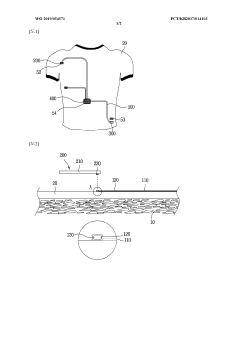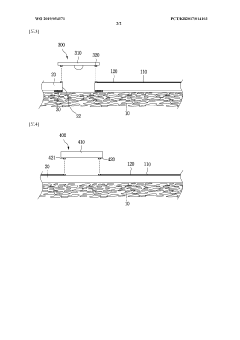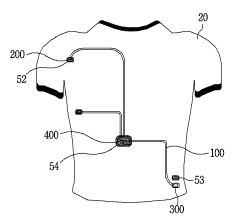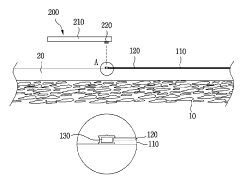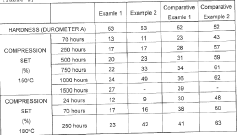Silicone Rubber's Role in Advanced Wearable Sensors
JUL 9, 20259 MIN READ
Generate Your Research Report Instantly with AI Agent
Patsnap Eureka helps you evaluate technical feasibility & market potential.
Silicone Rubber in Wearables: Background and Objectives
Silicone rubber has emerged as a pivotal material in the development of advanced wearable sensors, revolutionizing the field of personal health monitoring and human-machine interfaces. The journey of silicone rubber in wearable technology began in the late 20th century, with its unique properties of flexibility, biocompatibility, and durability making it an ideal candidate for skin-interfacing devices.
The evolution of silicone rubber in wearables has been driven by the increasing demand for non-invasive, continuous health monitoring solutions. Initially used primarily in medical-grade wearables, silicone rubber has since found applications in consumer electronics, sports performance tracking, and even fashion-forward smart clothing. This expansion has been facilitated by advancements in material science, allowing for the development of silicone rubber composites with enhanced electrical and mechanical properties.
A key trend in the technological progression of silicone rubber wearables has been the integration of multifunctional sensing capabilities. Modern silicone-based sensors can simultaneously measure various physiological parameters such as heart rate, blood oxygen levels, and skin temperature. This multifunctionality is achieved through the incorporation of conductive fillers and the development of novel fabrication techniques, enabling the creation of stretchable and self-healing electronic skins.
The primary objective of silicone rubber research in wearable sensors is to bridge the gap between rigid electronics and the soft, dynamic nature of human skin. This involves developing materials and manufacturing processes that can produce sensors with mechanical properties closely matching those of human tissue, while maintaining high sensitivity and reliability. Researchers aim to create sensors that can conform to complex body contours, withstand repeated deformation, and provide accurate, real-time data without causing discomfort or skin irritation.
Another crucial goal is to enhance the long-term stability and durability of silicone rubber-based wearable sensors. This includes improving resistance to environmental factors such as moisture, temperature fluctuations, and UV radiation, which can degrade sensor performance over time. Additionally, there is a focus on developing self-powered sensors by integrating energy harvesting technologies, such as piezoelectric or triboelectric generators, directly into the silicone rubber matrix.
As the field progresses, the integration of silicone rubber with other advanced materials and technologies, such as graphene, carbon nanotubes, and wireless communication systems, is expected to unlock new possibilities in wearable sensing. The ultimate aim is to create seamless, unobtrusive wearable devices that can provide continuous, accurate health monitoring and enhance human-machine interaction in various domains, from healthcare to augmented reality applications.
The evolution of silicone rubber in wearables has been driven by the increasing demand for non-invasive, continuous health monitoring solutions. Initially used primarily in medical-grade wearables, silicone rubber has since found applications in consumer electronics, sports performance tracking, and even fashion-forward smart clothing. This expansion has been facilitated by advancements in material science, allowing for the development of silicone rubber composites with enhanced electrical and mechanical properties.
A key trend in the technological progression of silicone rubber wearables has been the integration of multifunctional sensing capabilities. Modern silicone-based sensors can simultaneously measure various physiological parameters such as heart rate, blood oxygen levels, and skin temperature. This multifunctionality is achieved through the incorporation of conductive fillers and the development of novel fabrication techniques, enabling the creation of stretchable and self-healing electronic skins.
The primary objective of silicone rubber research in wearable sensors is to bridge the gap between rigid electronics and the soft, dynamic nature of human skin. This involves developing materials and manufacturing processes that can produce sensors with mechanical properties closely matching those of human tissue, while maintaining high sensitivity and reliability. Researchers aim to create sensors that can conform to complex body contours, withstand repeated deformation, and provide accurate, real-time data without causing discomfort or skin irritation.
Another crucial goal is to enhance the long-term stability and durability of silicone rubber-based wearable sensors. This includes improving resistance to environmental factors such as moisture, temperature fluctuations, and UV radiation, which can degrade sensor performance over time. Additionally, there is a focus on developing self-powered sensors by integrating energy harvesting technologies, such as piezoelectric or triboelectric generators, directly into the silicone rubber matrix.
As the field progresses, the integration of silicone rubber with other advanced materials and technologies, such as graphene, carbon nanotubes, and wireless communication systems, is expected to unlock new possibilities in wearable sensing. The ultimate aim is to create seamless, unobtrusive wearable devices that can provide continuous, accurate health monitoring and enhance human-machine interaction in various domains, from healthcare to augmented reality applications.
Market Analysis for Silicone-Based Wearable Sensors
The market for silicone-based wearable sensors is experiencing rapid growth, driven by increasing demand for health monitoring devices and advancements in sensor technology. Silicone rubber plays a crucial role in this market due to its unique properties, including flexibility, biocompatibility, and durability, which make it ideal for wearable applications.
The global wearable sensor market is projected to expand significantly in the coming years, with silicone-based sensors representing a substantial portion of this growth. Key factors contributing to market demand include the rising prevalence of chronic diseases, growing health awareness among consumers, and the increasing adoption of fitness tracking devices.
In the healthcare sector, silicone-based wearable sensors are gaining traction for continuous patient monitoring, remote diagnostics, and personalized medicine. These sensors enable real-time tracking of vital signs, movement patterns, and other physiological parameters, providing valuable data for both patients and healthcare providers.
The fitness and wellness industry is another major driver of market growth for silicone-based wearable sensors. Consumers are increasingly seeking devices that can monitor physical activity, sleep patterns, and stress levels. Silicone rubber's comfort and durability make it an excellent material for these applications, contributing to the popularity of fitness trackers and smartwatches.
Industrial and workplace safety applications represent an emerging market segment for silicone-based wearable sensors. These devices can monitor environmental conditions, worker fatigue, and potential hazards, improving overall workplace safety and productivity.
The sports industry is also adopting silicone-based wearable sensors for performance optimization and injury prevention. Professional athletes and sports teams are utilizing these sensors to track biomechanics, hydration levels, and other performance metrics.
Geographically, North America and Europe currently lead the market for silicone-based wearable sensors, owing to high healthcare expenditure and early adoption of new technologies. However, the Asia-Pacific region is expected to witness the fastest growth, driven by increasing disposable income, growing health awareness, and improving healthcare infrastructure.
Key challenges in the market include data privacy concerns, regulatory hurdles, and the need for improved sensor accuracy and reliability. Despite these challenges, the overall market outlook remains positive, with ongoing technological advancements and increasing consumer acceptance driving continued growth in the silicone-based wearable sensor market.
The global wearable sensor market is projected to expand significantly in the coming years, with silicone-based sensors representing a substantial portion of this growth. Key factors contributing to market demand include the rising prevalence of chronic diseases, growing health awareness among consumers, and the increasing adoption of fitness tracking devices.
In the healthcare sector, silicone-based wearable sensors are gaining traction for continuous patient monitoring, remote diagnostics, and personalized medicine. These sensors enable real-time tracking of vital signs, movement patterns, and other physiological parameters, providing valuable data for both patients and healthcare providers.
The fitness and wellness industry is another major driver of market growth for silicone-based wearable sensors. Consumers are increasingly seeking devices that can monitor physical activity, sleep patterns, and stress levels. Silicone rubber's comfort and durability make it an excellent material for these applications, contributing to the popularity of fitness trackers and smartwatches.
Industrial and workplace safety applications represent an emerging market segment for silicone-based wearable sensors. These devices can monitor environmental conditions, worker fatigue, and potential hazards, improving overall workplace safety and productivity.
The sports industry is also adopting silicone-based wearable sensors for performance optimization and injury prevention. Professional athletes and sports teams are utilizing these sensors to track biomechanics, hydration levels, and other performance metrics.
Geographically, North America and Europe currently lead the market for silicone-based wearable sensors, owing to high healthcare expenditure and early adoption of new technologies. However, the Asia-Pacific region is expected to witness the fastest growth, driven by increasing disposable income, growing health awareness, and improving healthcare infrastructure.
Key challenges in the market include data privacy concerns, regulatory hurdles, and the need for improved sensor accuracy and reliability. Despite these challenges, the overall market outlook remains positive, with ongoing technological advancements and increasing consumer acceptance driving continued growth in the silicone-based wearable sensor market.
Current Challenges in Silicone Rubber Sensor Technology
Despite the promising potential of silicone rubber in advanced wearable sensors, several significant challenges currently hinder its widespread adoption and optimal performance. One of the primary obstacles is the inherent trade-off between flexibility and sensitivity. While silicone rubber offers excellent flexibility, enhancing its sensitivity without compromising its elastic properties remains a complex task. This balance is crucial for accurate and reliable data collection in wearable applications.
Another major challenge lies in the long-term stability and durability of silicone rubber sensors. Exposure to various environmental factors, such as temperature fluctuations, humidity, and mechanical stress, can lead to degradation of sensor performance over time. This issue is particularly critical in wearable devices that are expected to function consistently under diverse conditions for extended periods.
The integration of silicone rubber sensors with other electronic components presents another significant hurdle. Achieving seamless connectivity between the soft, stretchable silicone rubber and rigid electronic elements while maintaining the overall flexibility of the wearable device is a complex engineering challenge. This integration is essential for creating fully functional and comfortable wearable sensors.
Biocompatibility and skin irritation are also concerns that need to be addressed. While silicone rubber is generally considered biocompatible, prolonged contact with the skin in wearable applications may lead to irritation or allergic reactions in some users. Developing formulations that minimize these risks without compromising the material's sensing capabilities is an ongoing challenge.
Manufacturing scalability poses another significant obstacle. Current production methods for silicone rubber sensors often involve complex, multi-step processes that are difficult to scale up for mass production. This limitation affects the cost-effectiveness and widespread adoption of silicone rubber-based wearable sensors in the consumer market.
Lastly, the development of standardized testing and calibration methods for silicone rubber sensors remains a challenge. The unique properties of these sensors, particularly their flexibility and stretchability, require novel approaches to ensure accurate and consistent performance measurements across different devices and applications.
Addressing these challenges requires interdisciplinary collaboration among materials scientists, electrical engineers, and biomedical researchers. Innovations in material composition, sensor design, and manufacturing processes are necessary to overcome these hurdles and fully realize the potential of silicone rubber in advanced wearable sensor technology.
Another major challenge lies in the long-term stability and durability of silicone rubber sensors. Exposure to various environmental factors, such as temperature fluctuations, humidity, and mechanical stress, can lead to degradation of sensor performance over time. This issue is particularly critical in wearable devices that are expected to function consistently under diverse conditions for extended periods.
The integration of silicone rubber sensors with other electronic components presents another significant hurdle. Achieving seamless connectivity between the soft, stretchable silicone rubber and rigid electronic elements while maintaining the overall flexibility of the wearable device is a complex engineering challenge. This integration is essential for creating fully functional and comfortable wearable sensors.
Biocompatibility and skin irritation are also concerns that need to be addressed. While silicone rubber is generally considered biocompatible, prolonged contact with the skin in wearable applications may lead to irritation or allergic reactions in some users. Developing formulations that minimize these risks without compromising the material's sensing capabilities is an ongoing challenge.
Manufacturing scalability poses another significant obstacle. Current production methods for silicone rubber sensors often involve complex, multi-step processes that are difficult to scale up for mass production. This limitation affects the cost-effectiveness and widespread adoption of silicone rubber-based wearable sensors in the consumer market.
Lastly, the development of standardized testing and calibration methods for silicone rubber sensors remains a challenge. The unique properties of these sensors, particularly their flexibility and stretchability, require novel approaches to ensure accurate and consistent performance measurements across different devices and applications.
Addressing these challenges requires interdisciplinary collaboration among materials scientists, electrical engineers, and biomedical researchers. Innovations in material composition, sensor design, and manufacturing processes are necessary to overcome these hurdles and fully realize the potential of silicone rubber in advanced wearable sensor technology.
Existing Silicone Rubber Solutions for Wearable Sensors
01 Composition and formulation of silicone rubber
Silicone rubber compositions typically consist of silicone polymers, fillers, and curing agents. The formulation can be adjusted to achieve specific properties such as hardness, elasticity, and heat resistance. Various additives may be incorporated to enhance performance characteristics or provide additional functionalities.- Composition and preparation of silicone rubber: Silicone rubber is typically composed of silicone polymers, fillers, and curing agents. The preparation process often involves mixing these components, shaping the mixture, and then curing it to form the final rubber product. Various additives can be incorporated to modify properties such as strength, flexibility, and heat resistance.
- Modification of silicone rubber properties: The properties of silicone rubber can be modified through the addition of specific compounds or by altering the molecular structure. This can include improving thermal stability, enhancing electrical properties, or increasing chemical resistance. Techniques may involve blending with other polymers or incorporating nanoparticles.
- Applications of silicone rubber: Silicone rubber finds wide-ranging applications due to its unique properties. It is used in medical devices, automotive parts, electrical insulation, and consumer products. Its biocompatibility makes it suitable for implants and prosthetics, while its heat resistance is valuable in industrial applications.
- Manufacturing processes for silicone rubber products: Various manufacturing processes are employed to produce silicone rubber products, including injection molding, extrusion, and compression molding. Advanced techniques like 3D printing are also being explored for creating complex silicone rubber structures. The choice of process depends on the desired shape, size, and properties of the final product.
- Innovations in silicone rubber technology: Recent innovations in silicone rubber technology focus on enhancing its performance and expanding its applications. This includes developing self-healing silicone rubbers, improving adhesion properties, and creating silicone rubber composites with enhanced mechanical or electrical characteristics. Research is also ongoing in the field of sustainable and eco-friendly silicone rubber formulations.
02 Manufacturing processes for silicone rubber products
Different manufacturing techniques are employed to produce silicone rubber products, including molding, extrusion, and calendering. These processes involve careful control of temperature, pressure, and curing conditions to achieve desired product specifications. Advanced manufacturing methods may incorporate automation and precision control systems.Expand Specific Solutions03 Modifications and enhancements to silicone rubber properties
Silicone rubber properties can be modified through various means, such as blending with other polymers, incorporating specific fillers, or chemical modifications. These enhancements can improve characteristics like tear strength, chemical resistance, or electrical properties, expanding the range of applications for silicone rubber materials.Expand Specific Solutions04 Applications of silicone rubber in various industries
Silicone rubber finds widespread use across multiple industries due to its unique properties. It is utilized in medical devices, automotive components, electronics, construction materials, and consumer products. The material's biocompatibility, durability, and resistance to extreme temperatures make it suitable for diverse applications.Expand Specific Solutions05 Innovations in silicone rubber technology
Ongoing research and development in silicone rubber technology focus on creating novel formulations, improving processing techniques, and developing new applications. Innovations include self-healing silicone rubbers, conductive silicone composites, and environmentally friendly production methods. These advancements aim to expand the material's capabilities and address emerging market needs.Expand Specific Solutions
Key Players in Silicone Rubber Wearable Sensor Industry
The market for advanced wearable sensors utilizing silicone rubber is experiencing rapid growth, driven by increasing demand for health monitoring devices and smart wearables. The industry is in an early growth stage, with significant potential for expansion as technology advances. Market size is projected to reach several billion dollars by 2025. Technologically, silicone rubber sensors are evolving quickly, with companies like Shin-Etsu Chemical, Wacker Chemie, and Momentive Performance Materials leading innovation in material development. Apple and Fitbit are leveraging these advancements to create cutting-edge consumer products. While the technology is maturing, there's still room for improvement in areas like flexibility, durability, and biocompatibility, presenting opportunities for further research and development.
Wacker Chemie AG
Technical Solution: Wacker Chemie AG has developed advanced silicone rubber compounds specifically designed for wearable sensors. Their ELASTOSIL® line of products offers customizable solutions for various sensor applications. These materials feature excellent elasticity, biocompatibility, and durability, making them ideal for skin-contact devices. Wacker's silicone rubbers can be formulated to achieve specific properties such as conductivity or transparency, enabling the creation of flexible and stretchable sensors [1][3]. The company has also introduced self-adhesive silicone gels that can be used for attaching sensors to the skin, improving comfort and data accuracy in long-term monitoring applications [2].
Strengths: Customizable properties, biocompatibility, and durability. Weaknesses: May require specialized processing techniques and potentially higher cost compared to traditional materials.
Apple, Inc.
Technical Solution: Apple has integrated silicone rubber into its wearable sensor technology, particularly in the Apple Watch series. The company uses a custom-developed silicone rubber for the watch bands and sensor array backing, ensuring comfort and flexibility while maintaining accurate sensor readings. Apple's approach combines silicone rubber with other advanced materials to create a seamless interface between the device and the user's skin. This integration allows for continuous heart rate monitoring, blood oxygen level detection, and ECG measurements [4]. The company has also patented several silicone-based innovations for improving sensor accuracy and durability in wearable devices [5].
Strengths: Seamless integration of sensors with comfortable materials, high-quality consumer products. Weaknesses: Proprietary technology may limit wider application in other devices.
Innovations in Silicone Rubber Sensor Technology
Smart garment integrated with wire coated with conductive silicone rubber
PatentWO2019054571A1
Innovation
- The integration of wires coated with elastic conductive silicone rubber allows for easy attachment and detachment of sensors and devices, with electrically conductive Velcro or metal snap buttons, and a breathable cover for durability and flexibility, enabling real-time biometric data collection during activities.
Silicone rubber composition
PatentWO2016162300A1
Innovation
- Incorporating a sulfur-containing compound reacted with a filler or filler surface-treated with a sulfur-containing compound into an addition-curable silicone rubber composition, which includes polyorganopolysiloxane, organohydrogenpolysiloxane, silica, and a catalytic amount of an addition reaction catalyst, to enhance compression set properties without requiring secondary thermal curing.
Biocompatibility and Safety Considerations
Silicone rubber plays a crucial role in the development of advanced wearable sensors, particularly in terms of biocompatibility and safety considerations. The material's inherent properties make it an ideal choice for direct skin contact applications, ensuring user comfort and minimizing potential health risks.
One of the primary advantages of silicone rubber in wearable sensors is its excellent biocompatibility. The material is chemically inert and non-toxic, reducing the likelihood of adverse reactions when in prolonged contact with human skin. This characteristic is essential for wearable devices that may be worn for extended periods, such as continuous glucose monitors or heart rate sensors.
Furthermore, silicone rubber exhibits remarkable flexibility and elasticity, allowing it to conform to the contours of the human body without causing irritation or discomfort. This adaptability ensures a secure fit and enhances the overall user experience, promoting consistent sensor readings and long-term adherence to wearable technology.
The material's low allergenic potential is another critical factor in its widespread adoption for wearable sensors. Unlike some synthetic materials that may trigger allergic responses in sensitive individuals, silicone rubber is generally well-tolerated by a broad range of users. This property significantly reduces the risk of skin irritation, rashes, or other dermatological issues associated with prolonged device wear.
In terms of safety considerations, silicone rubber's resistance to bacterial growth and ease of sterilization contribute to its suitability for medical-grade wearable sensors. The material can withstand various sterilization methods, including autoclaving and chemical treatments, without degrading or losing its essential properties. This feature is particularly valuable in healthcare settings where maintaining a sterile environment is paramount.
Additionally, silicone rubber's thermal stability and electrical insulation properties enhance the safety profile of wearable sensors. The material can effectively protect electronic components from moisture and environmental factors, reducing the risk of electrical malfunctions or short circuits that could potentially harm the user.
As wearable sensor technology continues to advance, researchers are exploring ways to further enhance the biocompatibility and safety aspects of silicone rubber. This includes the development of antimicrobial silicone formulations to prevent bacterial colonization on sensor surfaces and the incorporation of bioactive compounds to promote skin health during prolonged wear.
In conclusion, the biocompatibility and safety considerations of silicone rubber make it an indispensable material in the realm of advanced wearable sensors. Its unique combination of properties addresses many of the challenges associated with long-term, skin-contact devices, paving the way for more comfortable, reliable, and user-friendly wearable technology solutions.
One of the primary advantages of silicone rubber in wearable sensors is its excellent biocompatibility. The material is chemically inert and non-toxic, reducing the likelihood of adverse reactions when in prolonged contact with human skin. This characteristic is essential for wearable devices that may be worn for extended periods, such as continuous glucose monitors or heart rate sensors.
Furthermore, silicone rubber exhibits remarkable flexibility and elasticity, allowing it to conform to the contours of the human body without causing irritation or discomfort. This adaptability ensures a secure fit and enhances the overall user experience, promoting consistent sensor readings and long-term adherence to wearable technology.
The material's low allergenic potential is another critical factor in its widespread adoption for wearable sensors. Unlike some synthetic materials that may trigger allergic responses in sensitive individuals, silicone rubber is generally well-tolerated by a broad range of users. This property significantly reduces the risk of skin irritation, rashes, or other dermatological issues associated with prolonged device wear.
In terms of safety considerations, silicone rubber's resistance to bacterial growth and ease of sterilization contribute to its suitability for medical-grade wearable sensors. The material can withstand various sterilization methods, including autoclaving and chemical treatments, without degrading or losing its essential properties. This feature is particularly valuable in healthcare settings where maintaining a sterile environment is paramount.
Additionally, silicone rubber's thermal stability and electrical insulation properties enhance the safety profile of wearable sensors. The material can effectively protect electronic components from moisture and environmental factors, reducing the risk of electrical malfunctions or short circuits that could potentially harm the user.
As wearable sensor technology continues to advance, researchers are exploring ways to further enhance the biocompatibility and safety aspects of silicone rubber. This includes the development of antimicrobial silicone formulations to prevent bacterial colonization on sensor surfaces and the incorporation of bioactive compounds to promote skin health during prolonged wear.
In conclusion, the biocompatibility and safety considerations of silicone rubber make it an indispensable material in the realm of advanced wearable sensors. Its unique combination of properties addresses many of the challenges associated with long-term, skin-contact devices, paving the way for more comfortable, reliable, and user-friendly wearable technology solutions.
Environmental Impact and Sustainability of Silicone Wearables
The environmental impact and sustainability of silicone wearables are critical considerations in the development and adoption of advanced wearable sensors. Silicone rubber, a key material in these devices, offers several advantages in terms of sustainability, but also presents challenges that need to be addressed.
Silicone rubber is known for its durability and longevity, which contributes to the extended lifespan of wearable devices. This inherent durability reduces the frequency of device replacement, thereby minimizing electronic waste generation. Additionally, silicone rubber is resistant to degradation from environmental factors such as UV radiation and extreme temperatures, further enhancing the longevity of wearable sensors.
From a production standpoint, silicone rubber manufacturing processes have become increasingly efficient over the years. Many manufacturers have implemented closed-loop systems that recycle and reuse materials, reducing waste and energy consumption. The raw materials used in silicone production are also abundant, primarily derived from silica, which is one of the most common elements on Earth.
However, the environmental impact of silicone rubber production cannot be overlooked. The process involves energy-intensive steps and the use of certain chemicals that can have negative environmental effects if not properly managed. Efforts are ongoing to develop more sustainable production methods, including the use of renewable energy sources and bio-based alternatives for some components.
End-of-life considerations for silicone wearables are an area of growing focus. While silicone rubber is not biodegradable, it can be recycled through specialized processes. Some companies are developing innovative recycling technologies specifically for silicone-based products, aiming to create a circular economy for these materials.
The potential for microplastic pollution from silicone wearables is a concern that requires further research and mitigation strategies. As these devices are worn close to the body and exposed to various environmental conditions, there is a risk of small silicone particles being released into ecosystems.
Advancements in bio-based and biodegradable alternatives to traditional silicone rubber are showing promise for future wearable sensor applications. These materials aim to maintain the desirable properties of silicone while offering improved end-of-life outcomes. However, they are still in early stages of development and face challenges in matching the performance and durability of conventional silicone rubber.
As the wearable sensor market continues to grow, the industry is increasingly focusing on sustainable design principles. This includes designing for disassembly, using modular components that can be easily replaced or upgraded, and incorporating recycled materials where possible. These approaches aim to extend product lifespans and facilitate more effective recycling at end-of-life.
Silicone rubber is known for its durability and longevity, which contributes to the extended lifespan of wearable devices. This inherent durability reduces the frequency of device replacement, thereby minimizing electronic waste generation. Additionally, silicone rubber is resistant to degradation from environmental factors such as UV radiation and extreme temperatures, further enhancing the longevity of wearable sensors.
From a production standpoint, silicone rubber manufacturing processes have become increasingly efficient over the years. Many manufacturers have implemented closed-loop systems that recycle and reuse materials, reducing waste and energy consumption. The raw materials used in silicone production are also abundant, primarily derived from silica, which is one of the most common elements on Earth.
However, the environmental impact of silicone rubber production cannot be overlooked. The process involves energy-intensive steps and the use of certain chemicals that can have negative environmental effects if not properly managed. Efforts are ongoing to develop more sustainable production methods, including the use of renewable energy sources and bio-based alternatives for some components.
End-of-life considerations for silicone wearables are an area of growing focus. While silicone rubber is not biodegradable, it can be recycled through specialized processes. Some companies are developing innovative recycling technologies specifically for silicone-based products, aiming to create a circular economy for these materials.
The potential for microplastic pollution from silicone wearables is a concern that requires further research and mitigation strategies. As these devices are worn close to the body and exposed to various environmental conditions, there is a risk of small silicone particles being released into ecosystems.
Advancements in bio-based and biodegradable alternatives to traditional silicone rubber are showing promise for future wearable sensor applications. These materials aim to maintain the desirable properties of silicone while offering improved end-of-life outcomes. However, they are still in early stages of development and face challenges in matching the performance and durability of conventional silicone rubber.
As the wearable sensor market continues to grow, the industry is increasingly focusing on sustainable design principles. This includes designing for disassembly, using modular components that can be easily replaced or upgraded, and incorporating recycled materials where possible. These approaches aim to extend product lifespans and facilitate more effective recycling at end-of-life.
Unlock deeper insights with Patsnap Eureka Quick Research — get a full tech report to explore trends and direct your research. Try now!
Generate Your Research Report Instantly with AI Agent
Supercharge your innovation with Patsnap Eureka AI Agent Platform!
